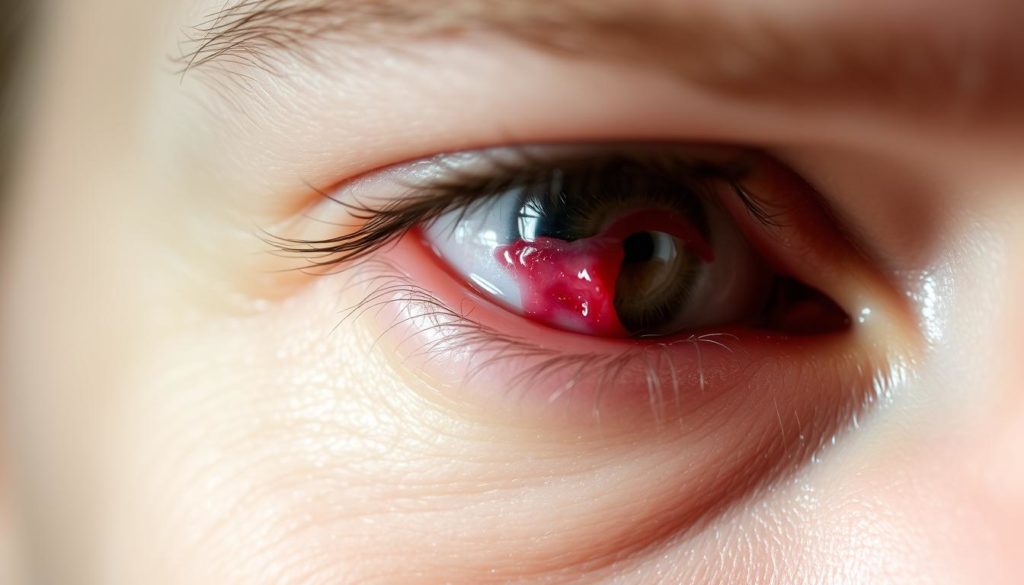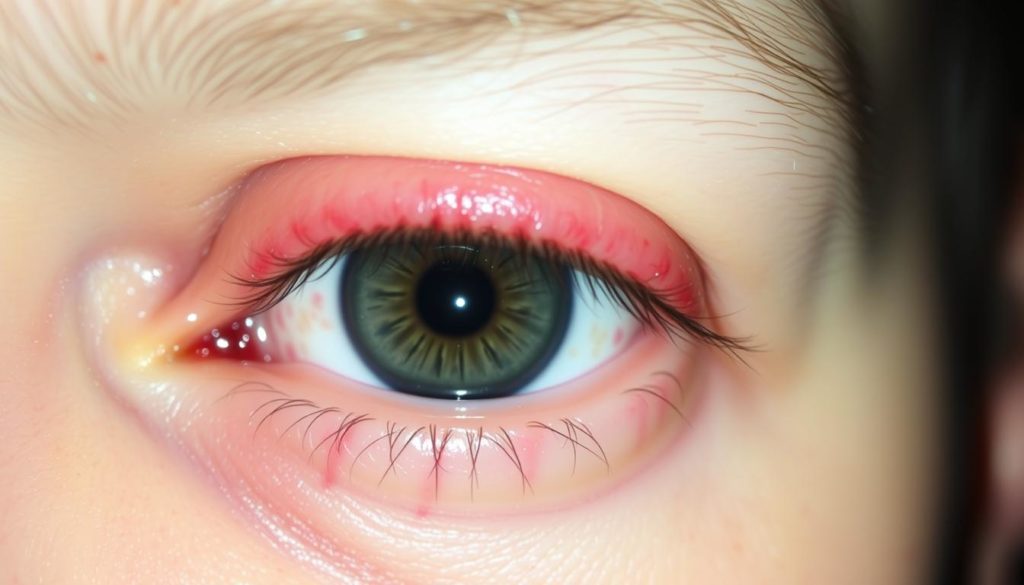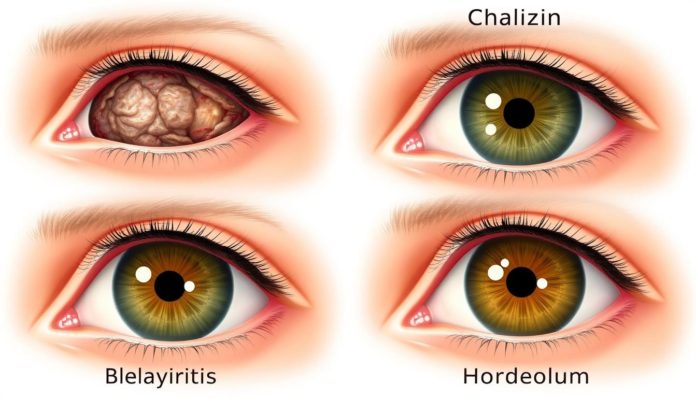Did you know about 20% of eye doctor visits in the U.S. focus on eyelid issues? Issues like swelling, pain, and infections are vital to eye health. They can range from slight annoyances to serious conditions that affect your eyesight. Knowing about these is key.
Eyelid issues cover many problems, including infections like conjunctivitis and styes. There are also structural concerns, such as ptosis and entropion. Conditions like blepharitis cause a lot of discomfort. They are common in eye care practices. Diseases like Graves’ disease also show up as eyelid problems. It’s important to see a doctor if you notice eye pain or changes in vision.
Injuries can seriously harm your eyelids, leading to swelling and pain. These injuries might affect how the eye drains. A specialist’s help might be needed in such cases.
We will explore the signs, causes, and treatments for various eyelid problems. Our aim is to help you keep your vision in top shape.
Common Signs and Symptoms of Eyelid Issues
It’s vital to know the signs of eyelid problems for eye health. Pain or discomfort in the eyelids can hint at serious issues that need quick care. We’ll explain the usual signs of eyelid troubles.
Eyelid Swelling
Swelling in the eyelids is a clear sign of a problem. This swelling could come from allergies, infections, or an injury. If your eyelids swell, watch for redness or itchiness to figure out what’s wrong.

Eyelid Pain
Eyelid pain demands immediate attention. It might mean you have an infection like a stye or chalazion, or maybe an injury. Knowing why your eyelid hurts is the first step to treating it and avoiding worse issues.
Blurry Vision
Blurry vision can signal a problem with your eyelids that affects your eyesight. Issues like blepharitis irritate the lids, leading to trouble seeing. Spotting blurry vision early helps get the right treatment quickly.
Causes of Eyelid Swelling and Pain
Eyelid swelling and pain come from many causes. Knowing these causes can help manage and prevent them effectively.

Allergies
Ophthalmic allergies often cause eyelid issues. These allergies lead to swollen, itchy, and red eyelids. Pollen, dust mites, and pet dander are common triggers. They can start a hypersensitive reaction, causing a lot of discomfort.
Infections
Many infections can make eyelids painful and swollen. Pinkeye and styes are key types. They develop from bacteria, viruses, or fungi. This results in eye inflammation and pain.
Trauma or Injury
Injury to the eye area also leads to swollen eyelids. This could be due to accidents, surgeries, or too much eye rubbing. Quick medical help is key to avoid more damage from eyelid trauma.
| Cause | Common Symptoms | Treatment Options |
|---|---|---|
| Ophthalmic Allergies | Swollen, itchy, red eyelids | Antihistamines, avoiding allergens |
| Infections | Pain, swelling, discharge | Antibiotic or antiviral medications |
| Eyelid Trauma | Swelling, bruising, pain | Cold compresses, medical assessment |
Types of Eyelid Problems
It’s very important to understand the different eyelid problems for eye health. Eyelid disorders appear in many ways. Each has its own signs and issues. Let’s look at some common eyelid anomalies seen in many people.
- Blepharitis: This condition means inflammation at the eyelashes’ base. It causes redness, irritation, and dandruff-like scales on eyelids.
- Chalazia and Styes: These are bumps on the eyelid. Chalazia are often painless cysts while styes are painful, infected glands.
- Ptosis: Here, the upper eyelid droops. It can affect vision and may need surgery to fix.
- Entropion and Ectropion: Entropion makes the eyelid turn in, causing cornea irritation. Ectropion makes the eyelid turn out, exposing the inner eyelid.
- Xanthelasma: These yellowish patches on eyelids indicate cholesterol issues. They can be a cosmetic concern and signal health problems.
- Eyelid Spasms: Known as myokymia, these are annoying involuntary twitches. They may relate to stress or fatigue.
- Dermatochalasis: This is sagging and too much skin on the eyelid. It can hinder vision and might need surgery.
Seeing an eye specialist early for these ocular skin issues is key. It prevents worse problems and keeps eyes healthy.
Blepharitis: Symptoms and Treatment
Blepharitis is a condition that inflames the eyelids. It leads to discomfort and annoyance. Knowing how to recognize and treat it is key to handling it well.
What is Blepharitis?
Blepharitis happens when bacteria and oily particles build up at the eyelash base. This causes redness, swollen eyelids, and a burning feel. It may also involve itching and discharge, and it can be related to other skin conditions like rosacea.
Treatment Options for Blepharitis
To manage blepharitis, stick to good eye hygiene:
- Apply warm compresses to the eyelids to soften crusts.
- Clean the eyelids with diluted baby shampoo or specific eyelid scrub.
- In some cases, doctors might give antibiotic or steroid eye drops. This helps reduce swelling and fight infection.
Preventative Measures
Regularly maintaining good eyelid cleanliness is vital for blepharitis control. Clean your eyelids each day. Also, manage any other skin issues like rosacea or seborrheic dermatitis. Doing this regularly can help stop symptoms from returning.
| Treatment | Purpose | Frequency |
|---|---|---|
| Warm Compress | Loosen crusts and reduce inflammation | Daily |
| Eyelid Scrub | Remove bacteria and oily flakes | Daily |
| Antibiotic Drops | Treat bacterial infection | As prescribed |
The Impact of Eyelid Trauma
An eyelid injury can happen due to dog bites, sharp objects, or blunt force. This can greatly affect your eye health. It’s vital to get immediate and suitable eye trauma care to avoid long-term harm.
Injuries often harm the tear ducts, cause bleeding under the eyelid, and damage nearby eye tissue. It’s important to treat these injuries quickly to prevent further issues.
Sometimes, an ocular emergency requires seeing an eye doctor. They might need to use stitches or surgery to fix the eyelid and its drainage. Acting fast helps with better recovery.
Below is a quick look at common eyelid traumas and their possible bad outcomes:
| Injury Type | Potential Complications |
|---|---|
| Dog Bites | Infection, tissue damage, tear drainage disruption |
| Sharp Object Wounds | Bleeding, risk of deeper ocular injury, need for stitches |
| Blunt Force | Edema, bruising, potential internal damage |
Eye trauma care right after an eyelid injury is key for eye health. Quick actions can stop an ocular emergency from getting worse.
Effective Remedies for Swollen Eyelids
Having swollen eyelids can feel uncomfortable and worrying. Knowing the right treatment can ease your discomfort and avoid further problems. Here are some helpful tips for swollen eyelids.
Home Remedies
There are several easy and effective ways to take care of swelling at home:
- Cool Compress: Apply a cool compress gently. It helps lower swelling and calms irritation.
- Proper Eye Hygiene: Clean your eyelids with a mild cleanser and water. This stops more irritation and helps heal.
- Rest and Hydrate: Make sure to rest and drink plenty of water. It helps your body heal faster.
Medical Treatments
If the swelling is bad or won’t go away, seeing a doctor is crucial. Medical treatments vary based on the cause:
- Antibiotics: Antibiotics might be needed if an infection caused the swelling.
- Steroids: For bad inflammation, steroids can help reduce swelling and pain.
- Anti-Allergy Medications: Antihistamines are useful if allergies are to blame.
When to See a Doctor
Home remedies don’t always work for swollen eyelids. You should see a doctor if:
- The swelling lasts more than 48 hours.
- You feel pain or your vision changes.
- You might have a disease like Graves’ disease.
Seeing an eye doctor gets you a treatment plan that fits your needs. It ensures you get the right care and recover properly.
Eyelid Surgeries: Understanding Blepharoplasty
You might know about blepharoplasty, a cosmetic eyelid surgery. It’s not just for looks. It helps with both beauty and eye problems.
When is Surgery Needed?
Surgery is needed when issues like dermatochalasis block your vision. Blepharoplasty benefits include looking better and seeing more.
What to Expect During Blepharoplasty
During the surgery, being ready matters. The doctor takes away extra skin, fat, and maybe muscle. This change makes your eyes look younger and more awake.
Recovery Process
Healing from eyelid surgery means dealing with bruises and swelling. The doctor will guide you on how to care for yourself after the surgery. Following these steps well helps you heal faster and better.
After this cosmetic eyelid surgery, people often feel and look younger. They also see better. Knowing how to heal properly and understanding the surgery’s good points are key.
Management of Eyelid Infections
Treating eyelid infections well often needs both home treatment and medical care. For really bad cases, surgery might be needed. Knowing how to take care of an eye infection is key to keeping your eyes healthy.
Starting with warm compresses and cleaning your eyelids carefully can help soothe symptoms and stop more problems. If there’s a bacterial infection or a lot of swelling, doctors may suggest antibiotics or steroids. These treatments aim to fix the main problem.
Seeing an eye doctor regularly is very important. If eye infections aren’t treated, they can damage the cornea and even lead to losing sight. Going for check-ups makes sure the treatment is working and changes can be made quickly if needed.
Sometimes, small surgeries are required to treat things like abscesses. The surgery might be about draining the abscess or taking out infected tissue. This helps to keep the infection from spreading.
Understanding Eyelid Problems and Injuries
It’s very important to learn about eyelid problems for eye health. Knowing what’s wrong and fixing it quickly is essential. This helps avoid big troubles later on.
Identification and Diagnosis
An eye specialist can figure out eyelid conditions by looking closely. They check how the eyelids look, their color, and shape. Sometimes, they might need pictures or tiny samples to learn more.
These steps help find eyelid problems early. It stops them from getting worse and hurting vision.
Long-term Effects
If eyelid issues aren’t fixed, they can cause many problems. These include damage to the front of the eye, infections, and ongoing eye issues. That’s why finding and treating them early is crucial for keeping eyes healthy.
Treating Eyelid Inflammation
Identifying common causes is crucial when treating eyelid inflammation. This could be due to skin issues, allergies, or systemic conditions. By knowing the cause, you can get better treatment for both eyelid and ocular inflammation.
Common Causes of Inflammation
Eyelid inflammation can come from many places. Allergies are a big reason, with pollen, dust, or animals causing issues. Things like eczema or psoriasis on the skin can lead to inflammation, too. Sometimes, infections or other diseases are to blame.
Relief Strategies
To quickly ease eyelid inflammation, try a few strategies. Cold compresses and antihistamine drops can help right away. Keeping your eyelids clean is also key for controlling symptoms. Often, these steps are enough to manage the problem.
Medical Interventions
Sometimes, inflammation won’t go away easily or is very painful. Then, seeing a doctor for eye care is needed. They might give antibiotics or medicine to lessen swelling. If allergies are causing it, staying away from what triggers it is key. For extreme cases, more intense treatments like shots or surgery might be the solution. This helps bring things back to normal and offers relief.
Preventing Future Eyelid Issues
To keep your eyelids healthy in the long run, mix good hygiene with protective steps. Here are key tips for eyelid care. They help avoid eye conditions and ensure eye protection.
Good Hygiene Practices
- Always wash your hands before touching your eyes to stop bacteria spread.
- Clean your eyelids often with a gentle, preservative-free cleanser.
- Make sure to remove makeup completely at night to prevent residue.
- When using contact lenses, stick to care and hygiene rules to avoid infections.
Protective Measures
To protect your eyes, take certain steps. Keep these in mind:
- Use safety goggles for risky activities like DIY projects or sports.
- Choose hypoallergenic cosmetics to avoid contact dermatitis.
- Get regular eye exams to catch and treat problems early.
Following these eyelid care tips every day can greatly lower your risk of eye problems. It can keep your eyes safe and eyelids healthy. Paying regular attention to these tips will help protect your vision and eye health.
Consulting an Eye Specialist
If you’re having eye or eyelid issues that won’t go away, it’s a good idea to see an ophthalmologist. An eye doctor will give you a full check-up to find out what’s wrong. This is key to getting the right treatment.
Specialist eye care is very important for tough or ongoing eye problems. A skilled ophthalmologist can offer custom eye health services. These might include surgery or regular check-ups. This kind of attention helps keep your eyes healthy for a long time and avoids more issues later.
Seeing an eye specialist brings several benefits:
- Full reviews of your eye health
- Use of the latest tools and tech for eye tests
- Custom plans for treatment and professional advice
- Quick and effective care for both sudden and long-term eye issues
Getting help from an ophthalmologist early can greatly help keep your eyes healthy. For the best care in eye health services, specialist eye care is key.
Summary: Maintaining Healthy Eyelids
Learning about eyelid health maintenance is key to avoiding eye issues. It’s important to clean your eyelids regularly and carefully. Also, make sure all makeup is removed before going to bed. This can stop common problems like blepharitis or infections.
If you notice symptoms like eyelid swelling, pain, or blurry vision, act quickly. Fast action can lead to more effective treatment and save your sight. Getting ahead of these symptoms can prevent bigger problems later. Whether it’s home remedies or doctor’s visits, tackle issues early.
Seeing eye care experts regularly is crucial for dealing with eyelid issues. They offer personalized advice and advanced treatments if needed. Plus, they’ll help with prevention tips. By following expert advice, you can keep your eyelids healthy. This helps protect your eyes and vision long-term.
FAQ
What are the common signs and symptoms of eyelid issues?
Eyelid problems can make your eyelids swollen and painful. They cause redness, itchiness, and blurry vision. You might feel like there’s something in your eye.
What causes eyelid swelling and pain?
Allergies, infections like conjunctivitis or styes, and injuries to the eye can lead to eyelid swelling and pain.
What types of eyelid problems exist?
Many eyelid problems can occur. These include blepharitis, chalazia, and styes. Others are ptosis, entropion, ectropion, xanthelasma, and eyelid twitching.
What is blepharitis?
Blepharitis is eyelid inflammation caused by bacteria and greasy flakes. It leads to irritation, redness, swelling, and a burning feeling.
What are the treatment options for blepharitis?
To treat blepharitis, keep your eyelids clean and use warm compresses. You might also need antibiotic or steroid eye drops.
How should one handle eyelid trauma?
If your eyelid is injured, see an ophthalmologist. You may need stitches or surgery, mainly if your tear drainage is damaged.
What are some effective remedies for swollen eyelids?
For swollen eyelids, cool compresses can help. It’s important to keep your eye clean. See a doctor if the swelling continues.
When is eyelid surgery necessary?
Eyelid surgery, or blepharoplasty, may be needed for better vision or looks. It removes excess skin and reshapes the eyelids.
How are eyelid infections managed?
To treat eyelid infections, use warm compresses and prescription meds. Sometimes, minor surgery is required to drain abscesses.
How are eyelid problems identified and diagnosed?
Eye specialists diagnose eyelid problems with thorough exams. They check the eyelid’s symmetry, color, and structure, along with other tests.
What are common causes of eyelid inflammation?
Eyelid inflammation comes from skin issues, allergies, and conditions like rosacea. Autoimmune diseases are also to blame.
What strategies provide relief for eyelid inflammation?
To ease eyelid inflammation, start with over-the-counter treatments. If needed, seek medical care for antibiotics or surgery.
How can future eyelid issues be prevented?
Prevent eyelid problems with good hygiene and proper contact lens care. Wear protective eyewear and get regular eye exams.
When should one consult an eye specialist?
If you have ongoing or serious eyelid issues, see an eye specialist. They can give the right diagnosis and treatment plan.


